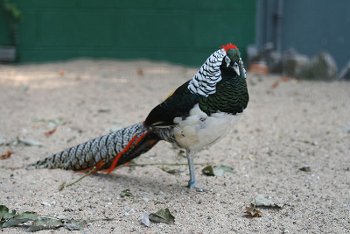Lady Amherst Pheasant
Category: Game Birds

Facts about the Lady Amherst's Pheasant, it is one of the land-feeding birds, which belongs to the genus Chrysolophus of the Phasianidae family. The binomial name of the bird is Chrysolophus Amherstiae and it is a species of the order Galliformes. This is a native bird of the southwestern parts of China and Burma, but it has been introduced into all parts of the world. The Lady Amherst Pheasant has set up a self-supporting, but currently the population is declining, untamed population in England, the monopoly of which is currently in Bedfordshire.
The Lady Amherst Pheasants prefer to live at higher altitudes from 6,000 feet to 15,000 feet (1818.18 meters to 4545.45 meters) in scrub, bamboo woodlands, and shrub regions of southeastern Tibet, upper Burma, southwestern China and northern Shan states. The Lady Amherst Pheasant is named after Sarah Countess Amherst, who is the wife of William Pitt Amherst, the Governor General of Bengal, who was accountable for sending the first sample of the bird in 1828 to London.
Features
The Lady Amherst's Pheasant has a well-built body, and the male adult bird has a body length that ranges from 51 inches to 56 inches (4.3 feet to 4.7 feet), whereas the female adult bird has a body length between 26 inches and 27 inches (2.2 feet and 2.3 feet). The total length of the tail of this bird is 150 inches (60 cm)
The male Lady Amherst's Pheasant bird is more colorful than the female ones. The crown of the male bird is metallic green with a pink crest. Its throat and face are black in color with metallic green marks. The male bird has a bluish-gray beak, and its legs and feet are also bluish-gray in color, with a black-and-white neck ruff. The Lady Amherst Pheasants have an enormously elongated black and white color tail with a yellow and red rump. A male Lady Amherst's Pheasant bird assumes complete plumage during the second year, pending that time, it looks like a female bird.
Being less colorful than the male birds, female birds are brown and tan, streaked and penciled with black color. They have white color dots on the top of their round tail feathers and they have grayish-blue legs.The female Lady Amherst's Pheasant bird is much less flashy, with a duller spotted tan plumage all over, analogous to that of the female Common Pheasant, but with improved barring.
The female Lady Amherst's Pheasant bird is very similar to the female Golden Pheasant, but this bird has cleaner underparts and a darker skull than the hen of that variety. In spite of the showy appearance of the male bird, these birds are extremely difficult to see in their normal habitat, which is thick, dark forests with dense undergrowth.
Diet
In the wild, the Lady Amherst's Pheasant mostly feeds on seeds, roots, berries, flowers, leaves, stems, tubers, buds, and insects. In the captive the bird is fed with grain, Avi pellets, insects, and fruit mix.
Behavior
The Lady Amherst's Pheasant birds are well capable of tolerating the most severe climatic conditions, with neither cold nor damp harming them. Usually, the Lady Amherst Pheasants stay away from thick forests. The Lady Amherst pheasant is a passive bird and can be accommodated with other bird varieties. A male bird can be accommodated with more than one hen. The Lady Amherst Pheasant is an extremely mysterious bird that always prefers running instead of flying. The Lady Amherst Pheasants have a range of vocalizations, such as contact, advertising, contentment and alarm.
The average lifespan of the Lady Amherst's Pheasant bird ranges from 6 years to 10 years, whereas in the captive, they can live up to 15 years.

 Back To Category Game Birds
Back To Category Game Birds